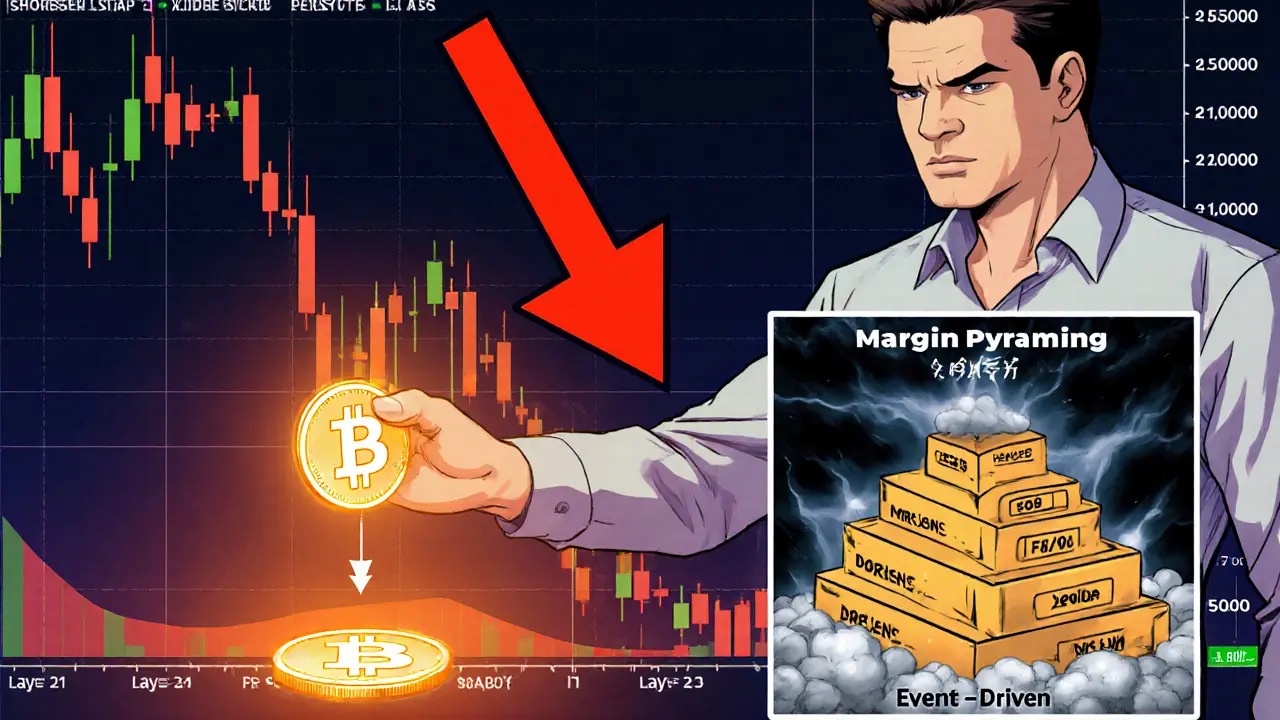Effective Margin Trading Strategies for Crypto Investors

Crypto Margin Calculator
Margin Trading Calculator
Margin Analysis
Margin Trading Strategies are advanced techniques that let traders amplify their exposure by borrowing funds against existing crypto holdings. By using a broker’s margin account, you can open larger positions than your cash balance alone would allow, but the power comes with heightened risk. Understanding the three core margin concepts - Initial Margin, Maintenance Margin and Margin Call - is the first step before you experiment with any strategy.
Below you’ll find a practical roadmap for experienced crypto investors who want to harness leverage without getting liquidated. The guide walks through four proven strategies, risk‑management habits, broker selection tips, and the tech tools that keep you ahead of market swings.
1. Core Margin Mechanics You Must Master
Every margin trade starts with three numbers:
- Initial Margin: the cash or crypto you must deposit to open a position. In most U.S.‑based crypto‑fiat brokers this sits at 50% of the trade value, mirroring Regulation T for equities.
- Maintenance Margin: the lowest equity percentage you can let your account drift to before the broker forces action. FINRA’s baseline of 25% is common, but many crypto platforms bump it to 30‑40% for volatile tokens.
- Margin Call: the notice you receive when equity falls below the maintenance level. Depending on the exchange, you may have 2‑5business days to add collateral or face an automatic liquidation.
Calculate your leverage ratio (borrowed amount ÷ equity) early on. A 2:1 ratio doubles buying power, but a 10% adverse move translates into a 20% loss on your equity.
2. Short‑Selling on Margin
Short selling lets you profit from price declines. You borrow a crypto, sell it at the current market price, then buy it back later at a lower price to return the loan. The mechanics look simple, but the risk is unlimited - if the asset rockets upward, you must cover at any price.
Key attributes:
- Risk Level: High - potential loss exceeds the initial investment.
- Typical Leverage: 2‑3× for most retail platforms; professional desks may go up to 5×.
- Skill Needed: Strong fundamentals and real‑time market monitoring.
- Best Conditions: Bear markets, strong negative news, or overbought technical setups.
Never short‑sell a token without a clear exit plan and a stop‑loss order set just above your entry point.
3. Margin Pyramiding - Letting Profits Fund New Trades
Pyramiding builds on winning positions. When a trade moves in your favor, you use part of the unrealized profit as new margin collateral, opening additional contracts or increasing position size. The idea is to compound gains while keeping the original equity untouched.
Because each new layer adds leverage, a small reversal can wipe out multiple tiers at once. Treat pyramiding like taking equity out of a house to buy another house - each loan amplifies exposure.
Best practices:
- Cap the number of layers (most traders stop after two).
- Maintain a buffer equal to at least 15% of total exposure.
- Use trailing stops that adjust as each layer matures.
4. Volatility or Event‑Driven Trading
Crypto markets react sharply to news, protocol upgrades, or macro events. Volatility traders open short‑term, margin‑funded positions to capture price dislocations that last minutes to hours. The key is rapid entry and exit, often using limit orders triggered by the VIX‑style crypto volatility index (e.g., CVIX).
Typical setup:
- Identify an upcoming event (hard fork, airdrop, regulatory announcement).
- Quantify expected price swing using historical data.
- Enter a leveraged long or short position with a stop‑loss set at 1‑2% of account equity.
- Close the trade within the event window, regardless of profit level.
This strategy demands disciplined risk caps because high leverage can turn a brief spike into a catastrophic loss.

5. Options Strategies Inside a Margin Account
Options add another dimension to margin trading. Two beginner‑friendly approaches are:
- Covered Call: Hold 100% of the underlying token and sell a call option against it. No extra margin required because the shares already secure the obligation.
- Buy‑Write (Long Call + Covered Call): Purchase the token and simultaneously sell a call at a higher strike. Brokers typically ask for 50% of the long‑share value as initial margin.
Both methods generate premium income while limiting upside. More advanced traders mix spreads, straddles, or protective puts, but those require deeper Greek knowledge and tighter monitoring.
6. Choosing the Right Broker for Crypto Margin
Brokerage support varies widely. Look for these hallmarks:
- Transparent Margin Rates: Interest should be disclosed daily; many platforms charge 0.02‑0.05% per day on borrowed crypto.
- Risk‑Management Tools: Real‑time margin‑call alerts, automated stop‑loss, and portfolio‑heat maps.
- Educational Resources: In‑depth guides on short selling, pyramiding, and options.
- Regulatory Standing: Licensed in a reputable jurisdiction (e.g., FCA, ASIC, or FINRA‑registered).
Full‑service firms like Merrill provide dedicated margin specialists, while discount crypto brokers may only offer basic calculators.
7. Risk‑Management Rules You Can’t Ignore
Across all strategies, the following rules keep you from getting wiped out:
- Never max out your margin limit. Keep at least 20‑30% of your equity free as a buffer.
- Set stop‑loss orders at the point where the trade’s risk‑reward ratio falls below 1:2.
- Monitor borrowing costs daily - high interest can erode profits quickly.
- Review maintenance‑margin requirements weekly; brokers can raise them during volatile periods.
- Use position‑sizing calculators to ensure each trade risks no more than 2% of total equity.
Adhering to these habits is more important than finding the perfect entry price.
8. Technology & Automation in Modern Margin Trading
Algorithmic risk‑management tools now integrate with most crypto exchanges. Features to watch for:
- Real‑time portfolio‑health dashboards that flag margin‑call thresholds.
- Auto‑scaling position sizes based on volatility (e.g., reducing leverage when CVIX > 30).
- API access for custom bots that enforce pre‑set stop‑loss and take‑profit levels.
Even a modest spreadsheet that updates daily equity, borrowed amount, and interest can save you from a surprise liquidation.

Comparison of Core Strategies
| Strategy | Risk Level | Typical Leverage | Skill Required | Ideal Market Condition |
|---|---|---|---|---|
| Short Selling | High (unlimited loss) | 2‑3× | Advanced - fundamentals & technicals | Bearish trends, overbought spikes |
| Margin Pyramiding | Medium‑High (compound risk) | 2‑4× (layered) | Experienced - position scaling | Strong trending moves |
| Volatility/Event‑Driven | Medium (short‑term spikes) | 2‑5× | Intermediate - rapid execution | High‑impact news, protocol upgrades |
| Options (Covered Call/Buy‑Write) | Low‑Medium (premium income) | 0‑0.5× (depends on spread) | Intermediate - Greeks basics | Sideways or modestly bullish markets |
Read this table before you pick a strategy - your risk tolerance and market outlook should guide the choice.
9. Practical Checklist Before Opening a Margin Position
- Verify your broker’s initial & maintenance margin percentages.
- Calculate the exact borrowing cost for the intended holding period.
- Set a stop‑loss that would not breach your buffer zone.
- Confirm you have enough free equity to survive a 10% adverse move.
- Test the trade on a paper‑account or with a tiny position first.
Following this checklist reduces the odds of an unexpected margin call.
10. Next Steps & Ongoing Learning
Margin trading isn’t a set‑and‑forget game. Keep sharpening these habits:
- Review your trade journal weekly - note why each margin call was triggered.
- Stay updated on regulatory shifts - FINRA and the SEC frequently tweak margin rules during market stress.
- Experiment with low‑cost simulation platforms before scaling to larger positions.
- Join reputable crypto‑trading communities where seasoned margin users share risk‑management tips.
When you blend disciplined risk controls with the right broker and technology, margin trading strategies become a powerful lever for crypto portfolio growth.
Frequently Asked Questions
What is the difference between initial margin and maintenance margin?
Initial margin is the cash or crypto you must deposit to open a leveraged position, usually 50% of the trade value. Maintenance margin is the minimum equity you must keep in the account after the position is live; falling below it triggers a margin call.
Can I short‑sell Bitcoin on a margin account?
Yes, most major crypto brokers let you borrow Bitcoin, sell it, and later buy it back. Remember, the loss can exceed your original investment, so always use stop‑loss orders.
How are margin interest rates calculated?
Brokers typically charge a daily rate based on the borrowed amount, expressed as an annual percentage rate (APR). For example, a 5% APR translates to roughly 0.014% per day. Rates can vary by token and borrowing size.
What safeguards can prevent a forced liquidation?
Maintain a buffer of unused margin (20‑30% of equity), use trailing stops, and keep an eye on the broker’s maintenance‑margin updates. Diversifying across uncorrelated assets also lowers the chance of a single market move wiping you out.
Is margin trading suitable for beginners?
It’s generally recommended only after you’ve mastered cash‑account trading, understand leverage effects, and have a solid risk‑management plan. Starting with low leverage (1.5×) and simple strategies like covered calls can help you build confidence.
Jennifer Bursey
July 25, 2025 AT 23:40Margin trading in crypto is not just a lever, it's a high‑octane conduit for portfolio amplification, demanding a surgeon's precision and a poet's flair. The initial margin requirement acts as your entry ticket, usually pegged at 50% of the notional exposure, which means you must marshal half of your capital before you can even whisper to the market. Maintenance margin, the ever‑vigilant sentinel, hovers around 25‑30% and will roar a margin call the moment your equity trembles beneath that line. A margin call is not a polite invitation; it’s a stark ultimatum to either replenish your buffer or watch your position crumble under automated liquidation. Leverage ratios, the multiplier on your risk, translate a modest 2:1 stance into a double‑edged sword where a 10% adverse swing morphs into a 20% loss. Short‑selling adds another layer of complexity, turning bearish sentiment into profit while exposing you to theoretically infinite loss if the asset rockets upward. Pyramiding, the art of reinvesting unrealized gains, can turbo‑charge returns but also stacks exposure like a Jenga tower-one misstep and the whole construct collapses. Volatility or event‑driven strategies capitalize on news catalysts, yet they demand razor‑sharp entry and exit timing, often measured in minutes. Options within a margin account, such as covered calls, provide a more conservative income stream, but they still tether you to collateral constraints. Broker selection is paramount; you need transparent margin rates, real‑time alerts, and regulatory robustness to avoid hidden pitfalls. Risk management rules-never max out your margin, keep a 20‑30% free buffer, and set stop‑losses at a 1:2 reward‑to‑risk ratio-are the bedrock of survivability. Automation tools, from portfolio dashboards to API‑driven bots, can enforce these safeguards, turning discipline into code. Remember, borrowing costs accrue daily; a 5% APR translates to a silent erosion of equity if positions linger. Diversification across uncorrelated assets can soften the blow of a single market upheaval, protecting you from a cascade of liquidations. Ultimately, mastering margin trading is a marathon of continuous learning, meticulous planning, and unwavering composure-any deviation can turn leverage into a financial guillotine.
Maureen Ruiz-Sundstrom
August 7, 2025 AT 05:25The guide reads like a manifesto for the reckless, glorifying leverage without enough emphasis on the inevitable ruin it can precipitate. While jargon impresses, it obscures the brutal arithmetic that most retail traders cannot survive. A disciplined trader would prune the hype and focus on capital preservation before chasing any of these strategies.
Kevin Duffy
August 19, 2025 AT 11:10Nice breakdown! 🚀
Michael Bagryantsev
August 31, 2025 AT 16:55Glad you liked it! Remember, every leveraged move should be paired with a clear exit plan. Keep the stress low and the profits steady.
Maria Rita
September 12, 2025 AT 22:41This is exactly the kind of step‑by‑step coaching I look for when I dip my toes into margin. The drama of leverage can be thrilling, but your checklist grounds the excitement in reality. I especially appreciate the emphasis on stop‑loss placement; it’s the safety net we all need. The pyramiding section felt like a high‑wire act-awesome when you’re balanced, disastrous when you’re not. Keep the language simple and the advice actionable, and more traders will survive the hype.
Jordann Vierii
September 25, 2025 AT 04:26Great points! Think of each layer as a rung on a ladder-climb with confidence, but never skip a rung. Stay motivated, keep your buffer solid, and you’ll turn those gains into lasting growth.
Lesley DeBow
October 7, 2025 AT 10:11One could argue that leverage is the modern alchemy of finance, turning risk into potential gold, yet it remains an illusion if the mind is not disciplined. The paradox lies in the promise of amplified returns versus the specter of amplified ruin. Thus, wisdom demands a balanced view, acknowledging both the allure and the abyss. The pathway forward is carved by prudence, not bravado. :)
Jim Greene
October 19, 2025 AT 15:56Love the philosophical spin! 🌟 Keep the optimism alive and let those risk controls be your compass. Every trade is a lesson, and every lesson builds confidence.
Teagan Beck
October 31, 2025 AT 21:41Good to see a balanced discussion without the usual hype.
Kim Evans
November 13, 2025 AT 03:26Appreciate the factual tone. When choosing a broker, always verify their margin rate transparency and regulatory standing-these are non‑negotiable. A solid heat‑map can alert you before a margin call hits. Also, keep a small portion of equity liquid to cover unexpected borrowing costs. Lastly, practice on a paper account to internalize these habits without risking capital.
Steve Cabe
November 25, 2025 AT 09:11The United States sets a high bar for margin regulation, and any trader ignoring that risks legal repercussions. Leverage should be used sparingly, especially when national financial stability is at stake. Our markets deserve participants who respect the rules, not reckless speculators. Stay disciplined and align your strategies with fiduciary responsibilities.